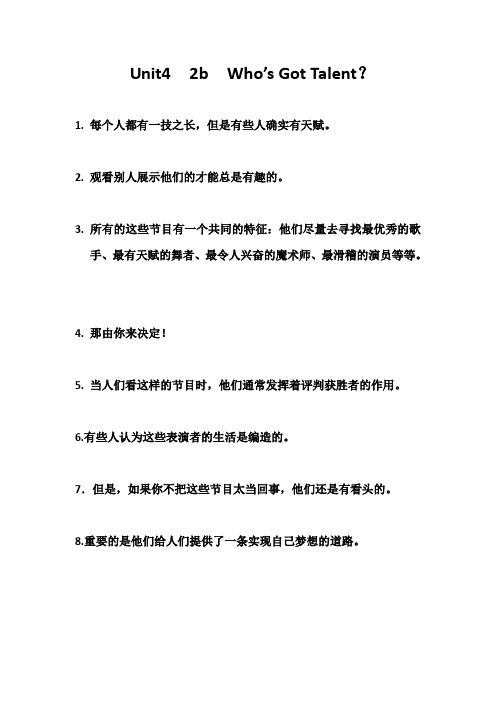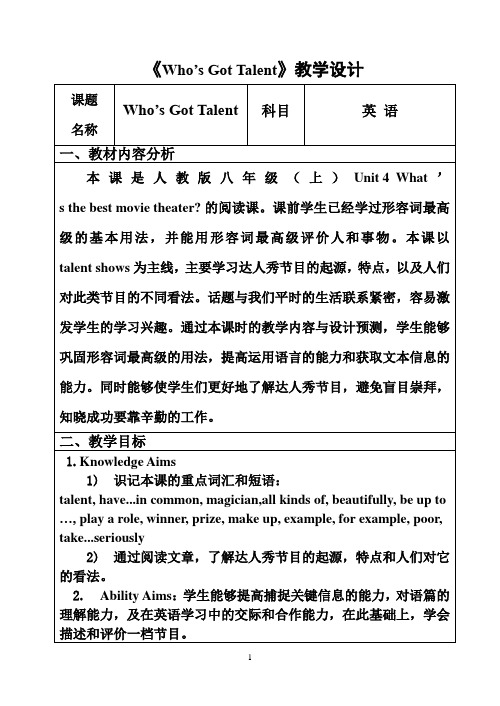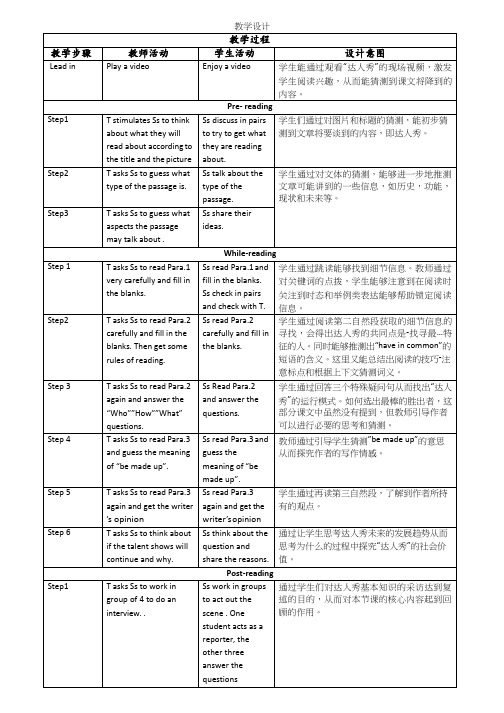Who has got talent
- 格式:pptx
- 大小:2.25 MB
- 文档页数:22

Unit4 2b Who’s Got Talent?
1.每个人都有一技之长,但是有些人确实有天赋。
2.观看别人展示他们的才能总是有趣的。
3.所有的这些节目有一个共同的特征:他们尽量去寻找最优秀的歌
手、最有天赋的舞者、最令人兴奋的魔术师、最滑稽的演员等等。
4.那由你来决定!
5.当人们看这样的节目时,他们通常发挥着评判获胜者的作用。
6.有些人认为这些表演者的生活是编造的。
7.但是,如果你不把这些节目太当回事,他们还是有看头的。
8.重要的是他们给人们提供了一条实现自己梦想的道路。




Unit4 Section B 2d Who’s Got Talent?【自主预习】单词初识一、听录音或根据音标朗读词汇表P29:talent~give共18个词。
并在课文中划出来。
◆现在我能流利朗读个单词。
二、根据汉语写出下列英语单词、词性及音标。
并在课文中划出来。
1 有相同特征7 认真…对待2 各种各样8 全世界3 越来越受欢迎9 成为现实4 由…决定10 中国达人秀5 发挥作用11 最有天赋的舞者6 编造12 最好的魔术师课前预习1. Who’s Got Talent? 谁是达人?【解读】此句中Who’s 为who has的缩写。
Have got表示“具有;具备”之意,相当于have。
此句字面上的意思是“谁有才华?”例如:We’ve got a lot of homework everyday. 【练习】单项选择。
Who’s Got Talent? A: Who is got talent? B: Who has got talent?2. That’s up to you to decide. 那由你自己来决定。
【解读】在英语中,be up to you是个习惯用语,用来表示“由你决定”,句子的主语通常为it, 有时也用this或that。
【举例】-- What would you like to eat for dinner?晚饭想吃什么?-- That’s up to you.由你决定。
【练习】用be up to造句。
_______________________________________________________ 4. Some think that the lives of the performers are made up. 有些人认为这些表演者的生平是编造出来的。
【解读】make up在此处是“编造“的意思,它的被动语态是be made up,被编造的意思。
【举例】My grandfather often makes up stories and tells us.我爷爷经常编故事给我们听。

who's got talent教案设计《Who's Got Talent》教案设计一、教学目标1. 通过学习本节课程,学生能够听、说、读、写谈论talent的词汇和表达方式。
2. 学生可以就talent进行讨论和协作,提高他们的合作能力和口语表达能力。
3.学生能够独立展示自己的talent,提高他们的自信心和演讲能力。
二、教学重难点1. 重点:本课程要求学生学习talent的相关词汇,如talented、skilled、gifted 等,从而提高学生的词汇量和表达能力;学生需要就talent进行讨论和协作,提高他们的合作能力和口语表达能力。
2. 难点:学生需要从自己的经验和表达方式中提取和表述自己的talent,提高他们的演讲能力和自信心。
三、教学内容本节课程分为三个部分:词汇学习,Talent Show合作,自我表达。
一、词汇学习目标:学习和理解talent相关的词汇。
1.向学生介绍talent相关的词汇,如talented、skilled、gifted等。
让他们思考这些词汇代表什么含义。
2.激发学生自己学习和汇总词汇的兴趣,教师可将学生分为小组,让学生在课前共同寻找talent的相关词汇和表达方式。
3.让学生进行词汇学习练习,如品尝词汇口感(让学生描述词汇的意义、用法和情感色彩)。
二、Talent Show合作目标:提高学生的合作能力和口语表达能力。
1.让学生分为小组,共同规划和实施talent show,每个小组可以准备自己的表演项目,如歌曲、舞蹈、朗诵等,展示自己的talent。
2.要求学生在小组内进行协作,探讨如何展示talent的技巧和方法,并于其他小组合作和交流。
3.小组间进行talent show,在展示中,促进同学之间的交往,体验成功和失败的感受。
三、自我表达目标:提高学生的演讲能力和自信心。
1.让学生自行准备talent展示的演讲稿,表达talent展示的意义和过程,并在talent show上进行演讲。
Who's got talent 教学设计文本分析:在英语阅读教学过程中,如阅读前、中后各环节能围绕文本特征设计阅读教学活动,可以充分发挥文本特征在文本解读中的引领作用,加深学生对文本的理解和感悟,提高阅读理解...学情分析:本校为农村中学,学生刚入学初,英语学习基本为一片空白,从26个字母学起,初一每个班74人,班级人数过多,从初一执教起,本人注重基础知识的积累,对单词书写勤抓狠抓,初二进行分班后,随着学习难度与广度的加深,加上初二特殊时期,学生的叛逆及厌学心理加重,两极分化逐渐严重,优生的语言表达能力较为流畅,能够独立地完成语篇翻译与阅读任务,而后进生在阅读上速度慢,不能正确理解文意,存在畏难情绪,丧失积极性。
Teaching Aids:multi-media, videoTeaching Aims:Knowledge aim: Students can know some basic information about the talent shows and master the usage of key words and the superlatives Ability aim:Students can improve their reading and speaking ability and learn to talk about the talent shows and use the superlatives correctly.Emotional aim:Students can be more confident to talk with others and learn to find some shinning points of others.Teaching Teaching Key Points:To master the usage of some new words and have a better understanding of the talent shows.Teaching Difficult Points:How to apply the superlatives into practice and use them to communicate with others correctlyTeaching Methods: Communicative Language Teaching, Task-based Languageprocedures:Step 1 Lead-inPlay a video “China's got talent”and ask students if they have ever watched this talent show and what they think of it.Step 2: Pre-readingAsk students some questions and invite some students to talk abouttheir opinions about these talented persons(1)Who is the most talent person you know ?(2)What can she or he do?Step 3: While-reading1.Extensive reading.Ask students to read the passage quickly and then conclude the main idea.2.Intensive reading.1). Ask students to read the passage again and answer the following questions:What does talent shows have in common?Who decides the winner?Why do some people not like these talent shows?What do you think of these talent shows2). Ask students to underline the superlatives.(1) Encourage students to discuss with partners.(1)Give explanation by giving some examples to help students understand them.(1)Ask students to make sentences by using superlativesStep 4: Post-reading1. Play the tape and ask students to read the short passage after the tape and pay attention to the pronunciations of the words and sentences.)2. Divide students into four groups and discuss who’s got talent in your class and then make a chart .Invite one of students to report the results to the whole class.Step 5: Summary and Homework:1.Summary: Ask one student to act as an assistant teacher to guide others to summarize what they have learned in this class. And then givea conclusion about this lesson.2.Homework:(1)Listen to the tape and read the short passage aloud.(2) Find more information about China's got talent on the Internetand write a short passage about it.Blackboard Design:Who's got talentFast reading:Main idea Discussion:Who’s got talent in our class? Careful reading:answer these questionsSome superlatives:The funniestThe most excitingThe most talentWho's got talent 教学设计文本分析:在英语阅读教学过程中,如阅读前、中后各环节能围绕文本特征设计阅读教学活动,可以充分发挥文本特征在文本解读中的引领作用,加深学生对文本的理解和感悟,提高阅读理解...学情分析:本校为农村中学,学生刚入学初,英语学习基本为一片空白,从26个字母学起,初一每个班74人,班级人数过多,从初一执教起,本人注重基础知识的积累,对单词书写勤抓狠抓,初二进行分班后,随着学习难度与广度的加深,加上初二特殊时期,学生的叛逆及厌学心理加重,两极分化逐渐严重,优生的语言表达能力较为流畅,能够独立地完成语篇翻译与阅读任务,而后进生在阅读上速度慢,不能正确理解文意,存在畏难情绪,丧失积极性。
whos got talent教案一、教学目标1.了解英国选秀节目《Who's Got Talent》的背景和特点。
2.掌握英语听说读写技能,提高英语水平。
3.培养学生的表演能力和自信心。
二、教学重难点1.掌握英语听说读写技能,提高英语水平。
2.培养学生的表演能力和自信心。
三、教学过程1.导入(5分钟)通过图片和视频展示《Who's Got Talent》的背景和特点,引导学生了解这个节目。
2.阅读(10分钟)让学生阅读一篇关于《Who's Got Talent》的文章,并回答问题:(1)What is "Who's Got Talent"?(2)What are the rules of the show?(3)What are some of the most famous acts in the show?3.听力(15分钟)播放一段《Who's Got Talent》的视频片段,并让学生回答问题:(1)What kind of act did the performer do?(2)What did the judges think of the performance?4.口语(20分钟)让学生分组,每组选择一个表演项目,并在课堂上进行展示。
老师可以根据实际情况选择评委进行评分。
5.写作(20分钟)让学生写一篇关于他们所选择的表演项目的文章,包括以下内容:(1)What is the name of the act?(2)What kind of act is it?(3)Why did you choose this act?(4)What are some of the challenges you faced while preparing for the act?(5)How did you overcome these challenges?6.总结(5分钟)回顾今天的教学内容,让学生分享自己的感受和收获。